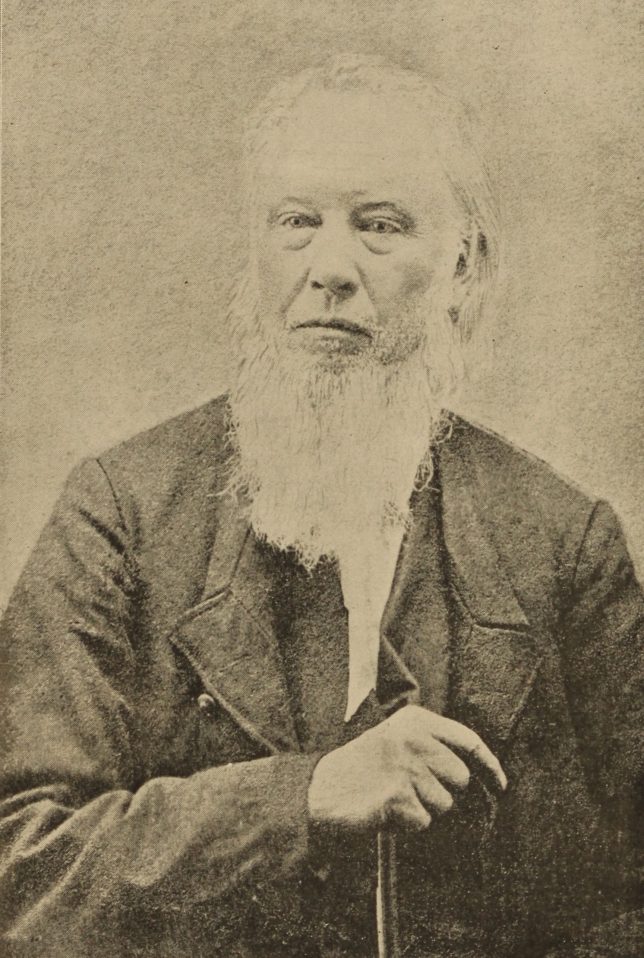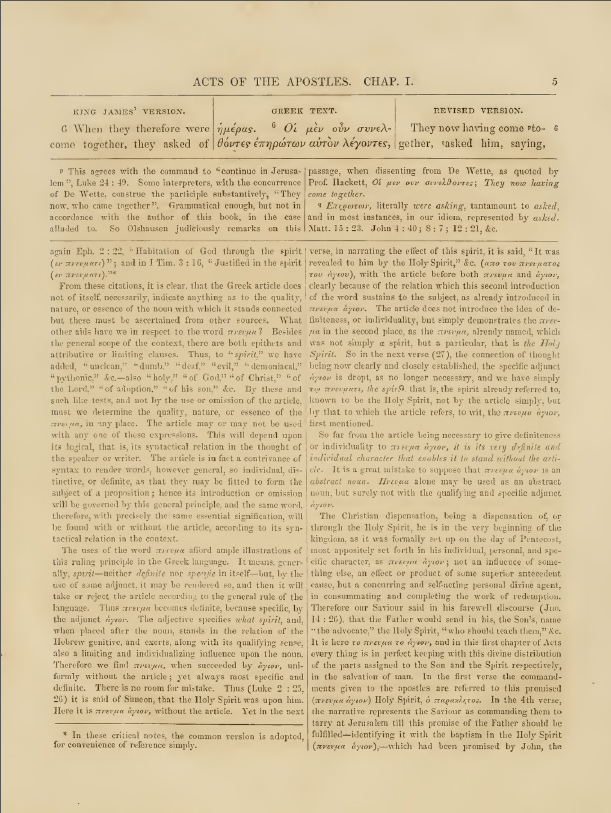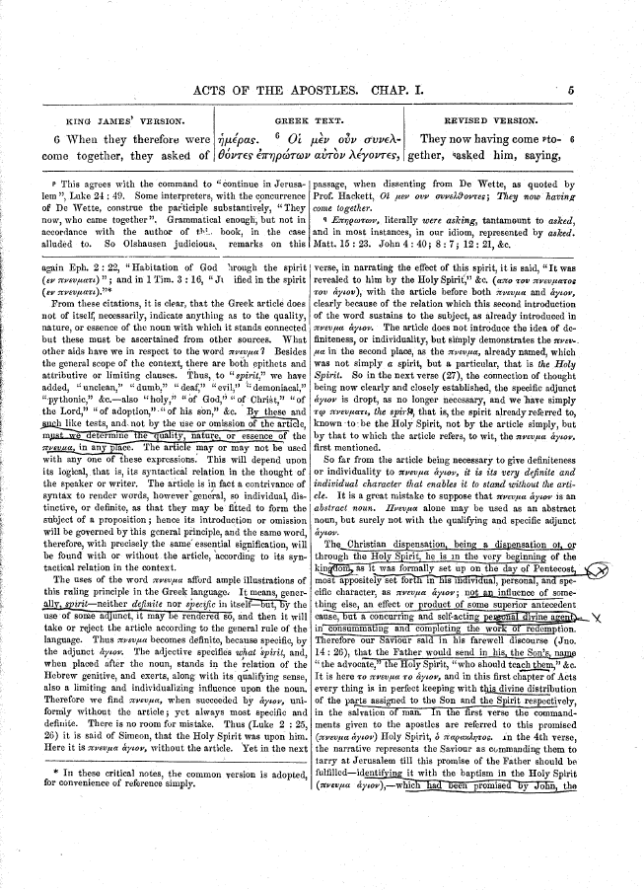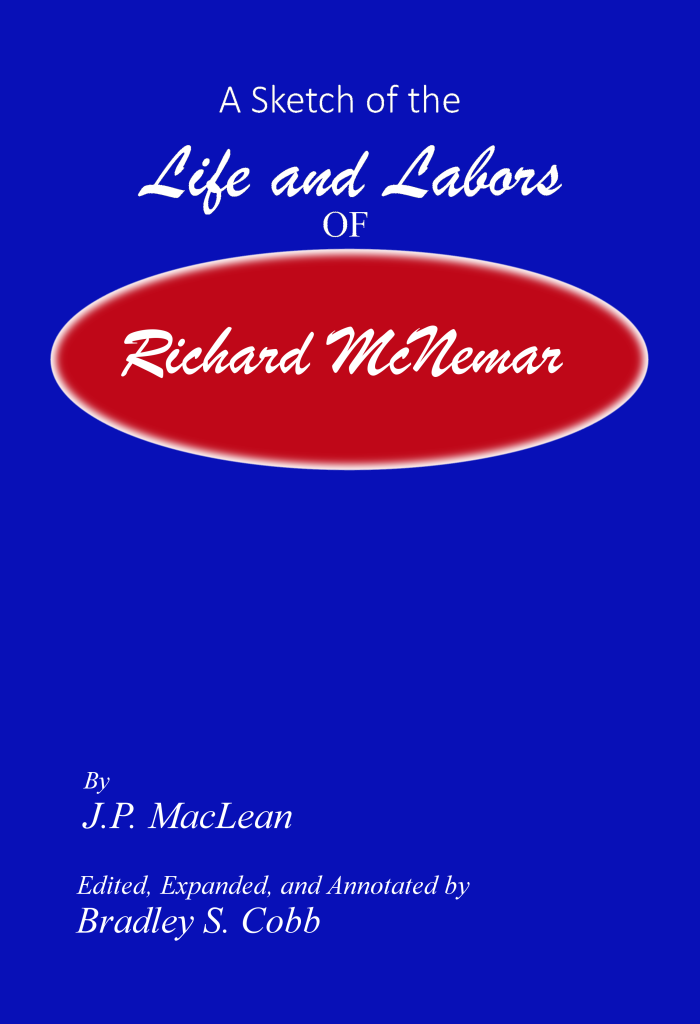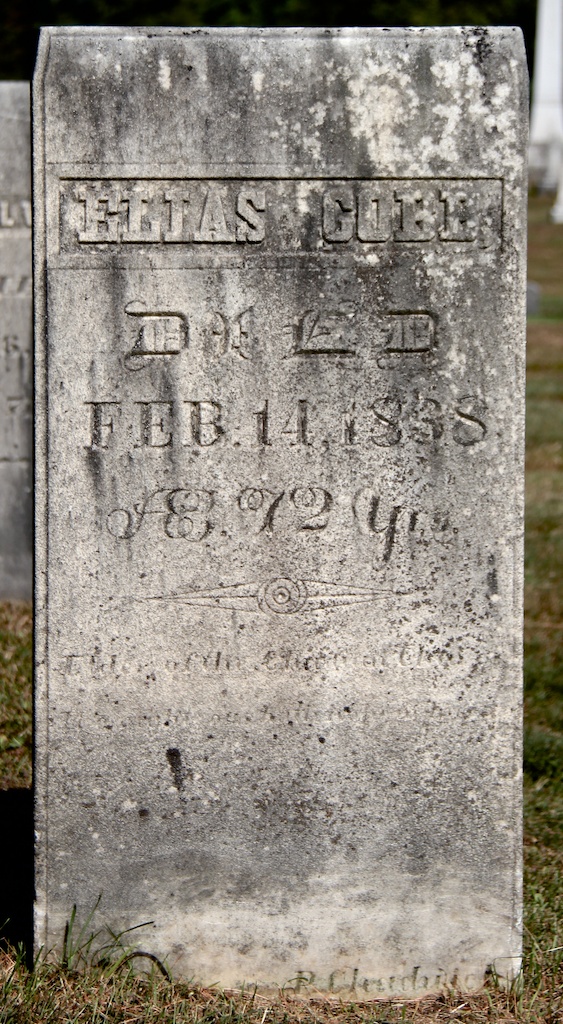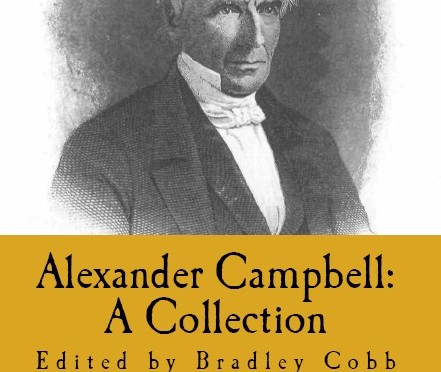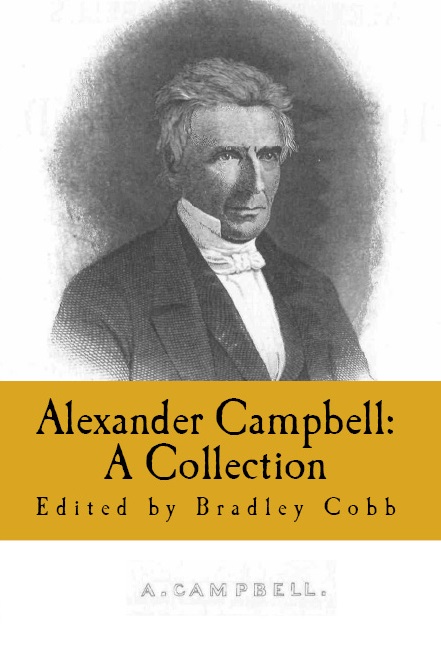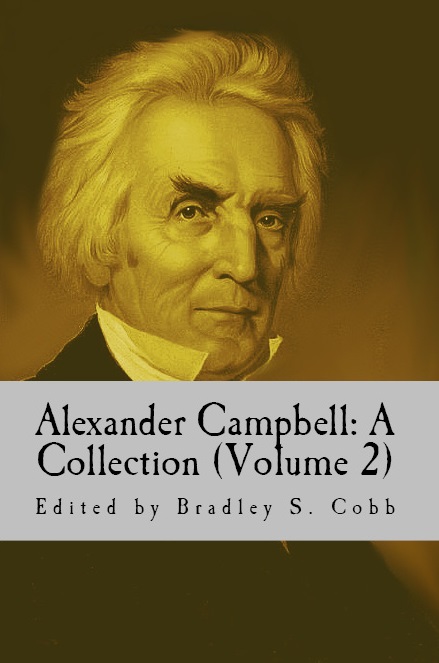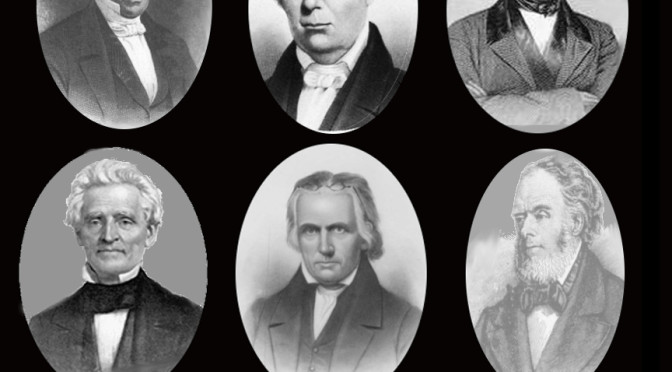From Sketches of Our Pioneers: a Brief Restoration Movement History.
CHAPTER XIII.
SAMUEL ROGERS.
This faithful servant of the primitive Gospel was born in Charlotte County, Virginia, Nov. 6, 1789. His father served through the Revolution and was present at the surrender of Cornwallis at Yorktown. In 1793, the family moved to central Kentucky, and settled in the forest two miles from Winchester, where they lived until September 1801, when they went to Missouri, known at that time as New Spain. They were four weeks on this journey and lived on venison, buffalo meat, and fish, which they found plentiful in their line of travel. The mother carried her Bible sewed up in a feather bed for fear of the priests. “All that I knew of the Christian religion, until I was grown to the stature of a man.” says Samuel Rogers, “I learned from those two preachers, my mother and the old family Bible which she took to that country in her feather bed.” He had the opportunity of attending school but three months in his life.
In 1809, his father returned to Kentucky, and in 1812 Samuel married Elizabeth Irvin, and soon after, under the preaching of Stone, became a firm believer in Christ, was convicted of sin and immersed. War being declared between England and the United States he volunteered and served throughout the struggle. After the war he entered upon the work of the ministry and preached on both sides of the Ohio River from Portsmouth to Cincinnati. In those days it was the current belief that the Lord called men to the ministry in some extraordinary way, that he opened a door of utterance and put words in the speaker’s mouth, and by a special interposition of power he would furnish his outfit, and direct and sustain him on his way. It is not strange with this faith the preacher would start on a tour of several months with only “a cut ninepence” in his pocket.
In 1818, he settled in Clinton county, Oh., where John I. Rogers was born January, 1819. Here he organized the Antioch Church and was ordained by two ministers of the Gospel. “Old Sister Worley” he says, “also laid hands on me, and I have always believed that I received as much spiritual oil from her hands as from the hands of the others.” Under the rules of the “New Lights” he could not baptize until this was done. He baptized forty persons at that time and during his ministry over 7,000. Not long after this he made his first preaching tour into Missouri. The country through which he traveled was wild, and often as he camped out in the forest he was awakened by the howl of wild beasts. He saw elk, deer, wolves and bears. He was overtaken by a prairie fire and escaped by firing the grass around him and keeping to the windward of it. He was three months on this tour as an evangelist.
His labors extended now in all directions. He journeyed as far east as Baltimore, where he preached a few discourses and baptized several persons, and held meetings also in Harford County, Md. This trip must have been a trying one for he speaks of his “many privations” and tells how he was forced to sell his Bible and hymn book to pay ferriage and other expenses. On one of these trips he lived for two days and nights on “a few apples,” but he tells us “the truth triumphed gloriously.” He made a half dozen tours through the State of Missouri, and traveled extensively in Kentucky, Indiana, Illinois, Ohio, Pennsylvania and Virginia preaching the Gospel to the people and receiving less than his actual expenses. “Both among our preachers and people,” he says, “there was prevalent a foolish sense of timidity upon the matter of taking up contributions of money for the ambassador of God. The little that we did receive was collected and given to us in a manner so sly and secret that the giver often appeared more like a felon than God’s cheerful giver. When a brother or sister in telling you ‘Good-bye,’ took hold of your hand in a clumsy sort of a way, with their hand half shut and half opened, you might look out for a quarter or a few cut ninepences. I have had money slipped into my vest and pocket, into my pants’ pocket, and in my sack while I was asleep. All this was done that the ministry might not be blamed, and for the purpose of keeping the tell-tale left hand in blissful ignorance of what the right had done.”
Rogers first met A. Campbell in 1825 at Wilmington, O. He heard him preach one sermon two hours in length, and afterward had a free and full conversation with him at the home of Jacob Strickle. As he listened to this great teacher, cloud after cloud rolled away from his mind, “letting in upon my soul light, joy, and hope that no tongue can express.” He looked upon Mr. Campbell as a modern Ezra sent to restore the lost law of God to the people. “The reformation,” he says, “had an easy conquest over all our churches, for the reason that they were right constitutionally; they had taken originally the Bible alone for their rule of faith and practice. This explains the fact of the early triumph of the reformation in the Blue Grass region of Kentucky. Stone, and those laboring with him, had constituted churches throughout central and northern Kentucky upon the Bible and the Bible alone, and all these without exception came early into the reformation. Stone’s reformation was the seed bed of the reformation produced by Campbell.”
In 1827 Rogers rode 200 miles on horseback to Warren, Oh., to attend the Mahoning Association and to meet with Walter Scott and the Campbells and their co-laborers. He began at once to preach these views with great fidelity and power. “I never made a fine sermon in my life,” he declared, “but I have preached a great many very fine sermons, yea as powerful sermons as were ever uttered on earth. But all of these fine sermons were borrowed. I borrowed them from Christ and the apostles. They contained the most sublime facts in the universe to be believed, the grandest commands to be obeyed, and the most precious promises to be enjoyed.”
November 14, 1833, the day after the great “star-shooting,” he started with his family for Indiana. His near neighbors in his new home were Joseph Franklin and wife, who were immersed Methodists. He began at once to preach in a school house and among the converts was Benjamin Franklin, who became a famous preacher of the primitive Gospel. Seven preachers came out of this meeting. His son, John I. Rogers, was one of them. For five years he labored in Indiana. In 1838 he moved back to Ohio, and in 1840 made his third missionary tour on horseback to Missouri. He was the second preacher to carry beyond the Mississippi the doctrine that the Bible and the Bible alone is a sufficient rule of faith and life, Thomas McBride having preceded him.
An idea of his preaching may be gathered from the sketch of a sermon about this time on election, I Pet. 1:1. He showed the election of believers to be according to an arrangement which God had previously made known; that elections in a state are carried on according to the law and the constitution previously arranged and made known, that is, according to the foreknowledge of the framers of the constitution; that every man, elected at all, must be elected according to that previous arrangement made known and promulgated; that the law clearly defined, first, the character of the person to be elected to office, and secondly, the mode and manner of holding said election. God has made and promulgated such a law for the election of men to a place in the kingdom of Christ; that kingdom was set up on Pentecost; Peter was the one chosen to publish the law of election and Jerusalem the place and Pentecost the time, and this one at the proper time and place opened the polls, laid down the rules regulating the election, and 3,000 men were elected according to the previous arrangement of God the Father, etc. He declared the same law in force today and the polls open, and asked all to come forward who desired to be chosen.
On his fifth tour to Missouri he had a most successful visit to Gasconade County. He tells how the primitive teaching was introduced here. A daughter of James Parsons heard him, was convinced of the truth, and demanded baptism at his hands, but her physician prevented her obedience. Later, finding her days were numbered, she desired her father, an unconverted man, to baptize her. He declared himself unworthy to perform the sacred rite. She urged him, saying that the validity of the ordinance did not depend on the administrator. Her family and friends were greatly moved by her dying entreaties. They sent far and near for a preacher, but could find none. Finally, the girl remembered her old colored “mammy” was a pious woman and she called for her and demanded that she should baptize her. The old colored woman consented, a bath tub was provided, and Sarah, the believing girl, was immersed, and rejoiced in the Lord. This opened the doors to the hearts of the people, and the Gospel triumphed in all that region. On this tour he associated with him a young man, Winthrop H. Hopson, who became afterward the gifted and eloquent Dr. Hopson, who did such noble service for Christ.
In 1844 Samuel Rogers settled in Carlisle, Ky., where he remained seven years. He continued to travel and preach constantly and in his eighty-fourth year made his last visit to Missouri. His end was full of peace. “I shall greet,” he said, “first of all, my Father, whose hand has led me all the journey through, and my Savior, whose grace has been sufficient for me in every day of trial. And next I shall look around for her whose love and goodness have imposed on me a debt of gratitude to God I can never repay. When we meet shall we not gather up the children and grandchildren and sit down under the shadow of the throne and rest?”
